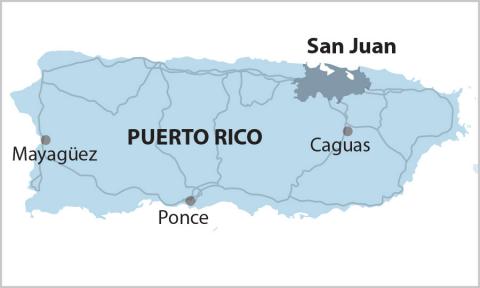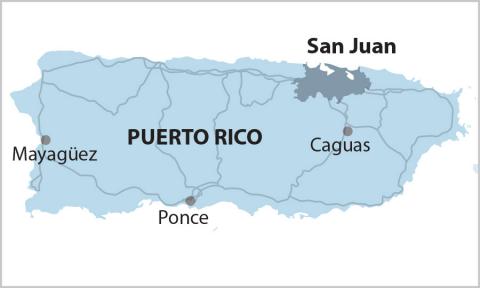Latest Puerto Rico plan for electric grid is a step in the wrong direction
Puerto Rico grid plan would increase rates, cause debt default, and send rates soaring
The Financial Oversight and Management Board (FOMB), Puerto Rico Electric Power Authority (PREPA) and grid operator LUMA Energy have made little progress in resolving the fundamental problems that have plagued Puerto Rico’s electrical system for decades.

The right direction would involve increasing renewable energy to cut fuel costs, spending federal dollars correctly and eliminating any claims for past debt. Taking these steps would allow PREPA to achieve a 20 cents/kilowatt-hour (kWh) rate and support economic growth.
But there’s also a wrong direction: Continuing to press for more expensive and highly volatile natural gas plants, using the federal dollars to support natural gas, and increasing rates to pay for $8.2 billion in old debt. Taking these steps would amount to a 30-plus cents/kWh rate for Puerto Rico and defeat economic growth. It will also lead to another round of debt defaults.
The plan approved by the FOMB goes in the wrong direction.
That’s IEEFA’s conclusion from the latest fiscal plan for PREPA, which was certified by the financial oversight board last week. The FOMB certifies fiscal plans as part of its mandate to oversee PREPA’s return to fiscal health and access to capital markets. Yet after five years of FOMB oversight over PREPA, the fiscal plan suffers from the same shortcomings that IEEFA has highlighted for years: Lack of tracking and documentation of savings initiatives, poor budgeting for fuel costs, and a focus on privatization that has yet to yield results in terms of system performance or costs.
The biggest fiscal problem facing PREPA is its uncontrolled fossil fuel expenses, which have driven electric rates from 18.2 cents/kWh in January 2021 to 33.4 cents/kWh today—on an island where the median income is $21,000. PREPA’s rates are the highest of any peer region and higher than the average household on the mainland United States. At 33.4 cents/kWh, PREPA ratepayers shell out 8% of their income for electricity; the average in the United States is 2.4%.
The only way to stabilize rates and PREPA’s budget over the medium to long term is to aggressively invest in renewable energy and to use billions of dollars of available federal funds to transition to a more resilient, renewable-based grid.
PREPA has signed agreements for additional renewable energy but has not yet moved forward with them
According to the fiscal plan, PREPA has signed agreements for additional renewable energy but has not yet moved forward with them. The plan gives no reason for PREPA’s failure but states that the Puerto Rico Energy Bureau has hired a third party to supervise the next rounds of renewable energy procurement. While the rest of the world moves forward with massive amounts of renewable energy Puerto Rico’s managers have been unable to deliver on a low-cost system of electricity production.
PREPA leadership continues to be hostile to renewable energy, instead advocating for new natural gas plants and the conversion of existing power plants to natural gas. This is happening even though natural gas prices at the Henry Hub have also been volatile recently, more than doubling between December 2021 and May 2022. With Russia’s invasion of Ukraine turning into a protracted struggle, high prices for oil and gas are the wave of the future. According to the recently passed budget for fiscal year 2023, the fuel and purchased power budget is expected to account for 73% of rates paid by utility customers, a stunning projection.
And as we will discuss in our next blog post, the FOMB is now advocating a new disincentive to rooftop solar—the only element of renewable energy that has been rapidly growing in Puerto Rico in recent years.
The newly approved plan holds out hope that the system can afford additional debt to pay back the bond holders if rates go up another 1.5 to 2.5 cents per kilowatt-hour. Rates are currently in the 30 cents/kwh range. Puerto Rico’s rates are higher than any comparable system. By the board’s own measure, the rates have become unaffordable. Yet the plan risks the possibility that rates will increase due to fuel costs, inadequate levels of federal funding, and new debt. IEEFA notes that LUMA, PREPA and FOMB have failed to meet most of the planned savings targets over the last six years.
Finally, the federal resources available to Puerto Rico for the grid must be used well. The plan warns that the funds may not be enough to cover actual costs. More resources will be needed for the system to meet its resiliency goals.
The FOMB appears to have abandoned its goal from 2018 that stable rates below 20 cents/kWh are necessary for “future economic growth and vitality.” The most recent fiscal plan does not project rates falling below 21 cents/kWh before 2050—even with no rate dollars spent to repay PREPA’s legacy debt.
It will be an uphill battle to do what is right for Puerto Rico’s ratepayers. The task is made impossible by the continued adoption of spending practices that lead to high fuel budgets and rising debt service costs.
En Espanol: IEEFA EE. UU.: El último plan de Puerto Rico para la red eléctrica es un paso en la dirección equivocada

















